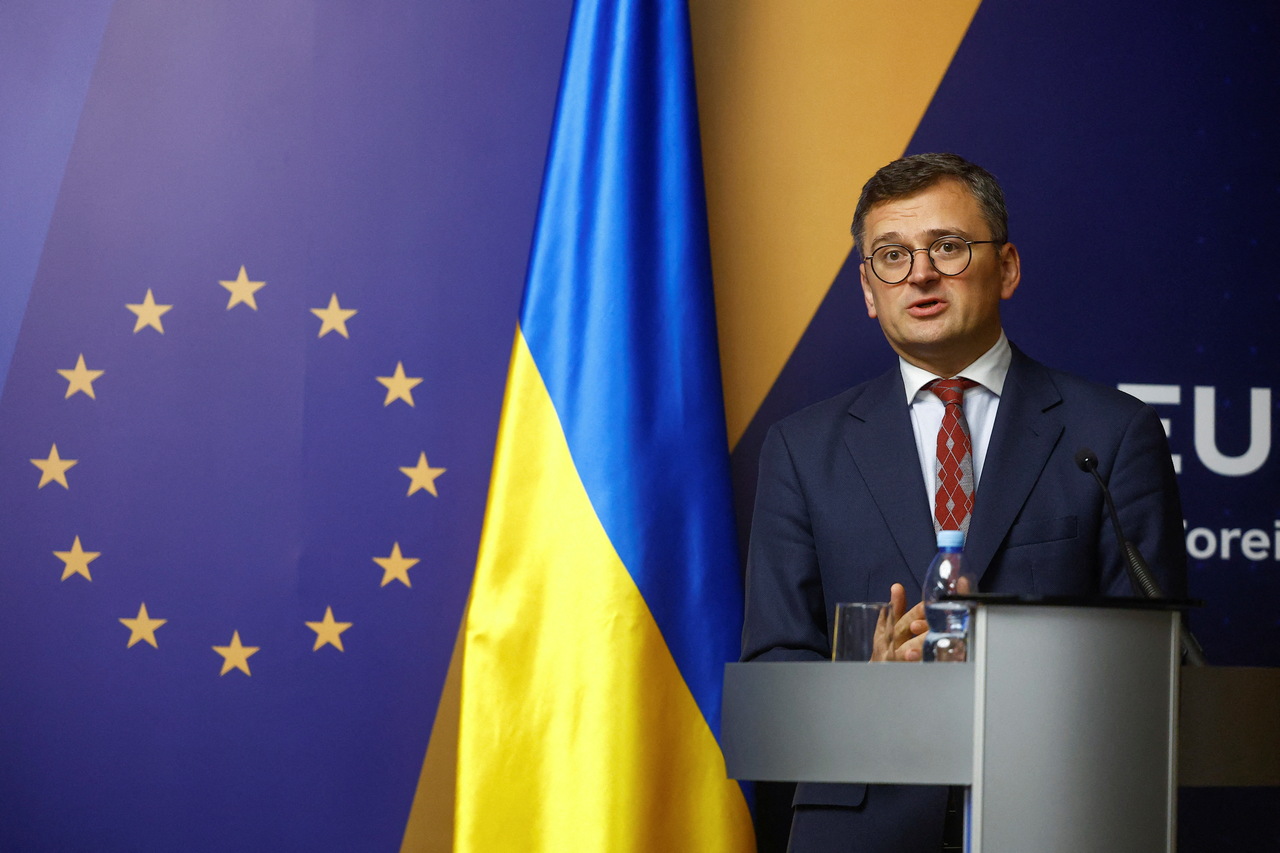U.S. Tightening Policy on Aid to Ukraine
The United States declares military support for Ukraine in the fight against Russia for “as long as it takes”. At the same time, It is putting pressure on the Ukrainian authorities to continue internal reforms, especially the fight against corruption. If Ukraine’s reforms are hollow or postponed until after the war, it may result in a loss of support from a significant part of the American public and political elite, which may carry the risk of a reduction in aid.
 KEVIN LAMARQUE / Reuters / Forum
KEVIN LAMARQUE / Reuters / Forum
Goals and Objectives of the Strategy for Ukraine
In August, the U.S. Department of State published an interdepartmental strategy on Ukraine that indicates that the U.S. has moved away from focusing solely on military support and towards a simultaneous emphasis on domestic reforms. The fundamental goal remains to support Ukraine so it wins the war with Russia, regains its territorial integrity, and achieves a long-term peace through military, financial, and humanitarian aid, as well as diplomatic support. The U.S. is the largest aid donor to Ukraine. Since the beginning of the Russian invasion, it has provided support totalling more than $75 billion, of which more than $44 billion has been military aid, more than $26 billion in the form of economic aid, and almost $4 billion in humanitarian funding. Maintaining American support remains crucial to Ukraine’s continued ability to defend and function in times of war.
The second goal indicated in the strategy is to support Ukraine’s political and economic reforms, aimed at enabling its further integration with the EU and NATO and helping in the post-war reconstruction of the country. Particular attention is on continuing the fight against corruption, increasing transparency in the economy, and limiting the influence of oligarchs along with the decentralisation of power (local government reform).
The third goal is to hold Russia accountable for war crimes and the destruction its forces have committed in Ukraine. The strategy involves helping Ukraine document and prosecute Russian crimes, reintegrating territories after occupation, along with its inhabitants and war veterans, as well as using blocked Russian assets to finance post-war reconstruction.
The last goal is to increase the credibility of supervision over Ukraine’s use of the support already provided to it. An audit is being conducted by the inspectors general of departments and agencies responsible for aid transfers. This goal is a response to the weakening support for further assistance to Ukraine among the American public—in an October Gallup survey, 41% of respondents said that the U.S. was providing too much support, while 33% considered it enough (in July, it was 29% and 43% respectively). It also stems in part from allegations by some among the right-wing American political elite about insufficient supervision over aid and supposedly poor spending choices.
Debate in the United States
Further support for Ukraine is being met with resistance from some in the American political elite, especially members of the Republican Party, who want the aid to end or at least be drastically reduced to the level it was before the Russian invasion in 2022 (i.e., about $300 million. Annually). Some of this is because of isolationist tendencies among today’s American conservatives, a result of not seeing benefits from Ukraine limiting Russia’s military potential despite using, among others, American weapons, even without involving U.S. troops in military operations. Some Republicans are pushing for additional supervision over aid funds for Ukraine by, among others, seeking to appoint a special inspector general, essentially an auditor; bills on this issue have been presented in both chambers of Congress.
At the same time, the adoption of another pool of funds for Ukraine that was not included in the provisional budget for the next year is being extended. President Joe Biden has asked Congress for more than $61 billion in support for Ukraine as part of a broad crisis package that includes aid for Israel, funds for border protection and for strengthening U.S. influence in the Indo-Pacific. The pool of military aid amounts to more than $45 billion and includes not only financing support for Ukraine but also logistics and orders to fill gaps in U.S. stockpiles. Another $16 billion is earmarked for economic aid. In addition, part of a package totalling more than $9 billion in humanitarian aid—addressing both the Russian invasion and the war in the Gaza Strip—is meant for Ukraine. The package in its original form was rejected by the Senate because of a lack of concessions to Republicans, who want to tighten migration policy.
Some of the Republicans also want to break up the crisis package and first adopt aid measures for Israel and then force concessions regarding Ukraine, especially in the field of economic and humanitarian aid. The House of Representatives, which is under Republican control, formally adopted a stand-alone support package for Israel, but this approach is opposed by Democrats in the Senate and President Biden has announced he will veto it.
Ukrainian Context
Despite the ongoing war with Russia, Ukraine is trying to continue the reforms. At the beginning of November, the European Commission (EC) positively assessed Ukrainian efforts to increase the independence of the judiciary and anti-corruption institutions and to limit the influence of oligarchs on national politics and the economy. On this basis, the EC recommended the Member States open accession negotiations with Ukraine.
The Republicans’ assertions that the Ukrainian authorities are misspending U.S. foreign aid has not been confirmed. At the beginning of 2023, the Treasury Department and the United States Agency for International Development (USAID) announced independently that U.S. auditors found no irregularities in Ukraine’s use of American military and financial support.
Despite this, corruption scandals involving high-level politicians and government officials continue to overshadow the Ukrainian reforms. In September, against a background of a series of scandals regarding procurement for the Ukrainian army, almost the entire management of the Ministry of Defence was changed, including the head of the ministry. President Volodymyr Zelensky’s allegedly lenient attitude towards people close to him suspected of involvement in corruption fuels political forces questioning the validity of further assistance to Ukraine, including Republicans who criticise it. Together with the persistent refusal to reform the Security Service of Ukraine, which continues to be used for political purposes, this calls into question the sincerity of the Ukrainian authorities regarding their reform intentions.
Public opinion polls conducted this summer in Ukraine indicate not only the clear desire from Ukrainian society for further reforms but also acceptance of the policy of conditionality on the part of Western partners. Apart from the ongoing war, Ukrainians commonly point to corruption as the main problem and believe that the president is primarily responsible for fighting it. More than half of the respondents believe that it is appropriate for foreign partners to link further military aid to Ukraine with the effective fight against corruption in the country.
Conclusions and Perspectives
The U.S. will continue to support Ukraine to enable it to defend itself against Russia. At the same time, however, it will place greater emphasis than before on the implementation of political and economic reforms by the Ukrainian authorities in order to engage in the post-war reconstruction of Ukraine in the future and support its integration with NATO and the EU. The future involvement of American state institutions and the private sector in Ukraine will largely depend on the level of advancement of requisite changes. The current state of reforms in Ukraine is unlikely to affect the scale of military support from the current U.S. administration, which, according to its declarations, will continue after Congress provides funds for this purpose. However, if Ukraine postpones or initiates a mirage of reforms, it risks losing support among most U.S. representatives and senators. Suggestions appearing among American experts to limit aid to Ukraine in order to persuade it to compromise with Russia have not been reflected in the administration’s position.
The Ukrainian authorities, for their part, face a dilemma whether to introduce reforms that are unpopular among the political elite, thus risking a weakening of the cohesion of the ruling camp and potentially its ad hoc majority in parliament, or to continue postponing some reforms and risk losing the support of foreign partners. In this situation, the continuation of reforms will largely depend on further pressure from its partners, including Poland, and Ukrainian society, which increases the political cost of inaction by the Ukrainian authorities. In the near future, the impetus for internal changes in Ukraine will primarily be the EU accession process. A slowdown of changes may reinforce the Ukrainian power elite’s belief in the futility of introducing politically controversial reforms.






